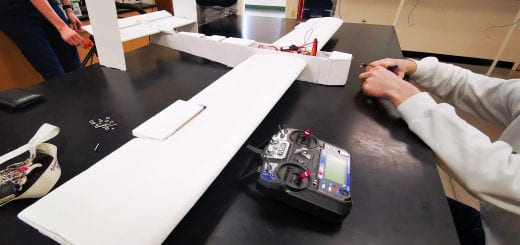The STEM Power of Rocketry
Rocketry, at the high-power level, really offers lots of opportunities for STEM learning. I have been involved with L1 and L2 rocketry for more than a decade and the DeArmond Makerspace in Price Science Commons has been involved with rocketry for over five years. So, first, what is L1 and L2 high power rocketry? Well, it refers to the mass of the rocket (1,500 grams or more), the mass of the fuel on the rocket (125 grams or more), and the impulse of the motor (>80 Newton-seconds or thrust multiplied by the burn time of the propellant) driving the rocket for a L1 level flight. Level-2 Rocketry deals with motors that have an impulse range of 2,560–5,120 Newtown-seconds. There is even a Level-3 classification, but that is beyond what I will cover.
There are several features that make high-power rocketry particularly interesting. First, it deals with a size of rocket that can easily be worked on and modified. Using design programs such Open Rocket and RockSim you can design your own rocket.
Second, and still related to the first reason is that high power flights are much longer than your typical hobbyist rocket launch, giving the designer time to collect data on the flight and check its performance. Third, which is also related to the first 2 reasons, is that a high-power rocket is big enough to have a payload to carry electronic sensors that collect data on the rocket’s performance. Since these rockets fly rather high +2,000 ft and much more, and therefore can drift a bit far as they come down by parachute, they are big enough for even more electronics. The addition of tracking systems makes recovering the rocket easier. These systems require some familiarity with radio communication (see my past posts on that topic).
So, to recap, high power rocketry involves physics covering thrust, impulse, drag/aerodynamics, design, centers of pressure and gravity, stress/strain, electronics, and radio communication; chemistry covering propellant materials and burn time; and weather, all tied up into a single package.
I mentioned burn-time earlier as part of the calculation of determining a rocket motor’s impulse, but it is also important in helping calculate when a rocket reaches apogee. In a rocket flight, the motor will propel the rocket upwards against the force of gravity. At some point the fuel will be spent and the rocket will “coast” upwards until air friction and gravity bring it to halt. It is at this point, at apogee, at its highest point before falling, when it comes to momentary stop, that the parachute needs to be ejected and deployed. If the parachute is deployed earlier, the line connecting the parachute to the air frame, will slice down the side of the rocket ripping it apart as it slows the motion of the speeding rocket. If the parachute is deployed to late, the rocket will begin to fall and accelerate very quickly under gravity’s force. Again, the line from the deployed parachute will slice down the side of the rocket ripping it apart as it slows the motion of the now falling and speeding rocket.
High power rocketry does require knowledge testing and licensing, and there are age restrictions. These are all important to keep everyone safe. If you or your students are high school aged or younger, check out the American Rocketry Challenge. There is still an incredible amount of work that can be done at this level too, and there are some amazing scholarships available for those that compete well in the challenge. For those in the college bracket, check out the National Association of Rocketry (NAR) and Tripoli. If you are in Oregon, where we are, check out the Oregon Rocketry Association.
 The author and his Green Lantern L2 Rocket launching in the Black Rock Desert
The author and his Green Lantern L2 Rocket launching in the Black Rock Desert






